The City of Indianapolis deploys the word “monument†far more than most American cities, and not without good reason. Most metrics indicate that it has the second highest concentration of memorials, landmarks, and civic plazas (behind only our nation’s capitol), and the landmark that gives the city its well-defined absolute center—the Soldiers’ and Sailors’ Monument—comprises a geometrically precise plaza called “Monument Circle‖hence the nickname “Circle Cityâ€. Indy’s popular marathon takes the name “Monumentalâ€, not only as a hat-tip to the city’s numerous prodigious landmarks (many constructed out of Indiana limestone), but because the marathon’s trajectory provides a sort of monumental connect-the-dots.
Most people reading already know all this. But, for all the city’s smartly located landmarks (mostly concentrated in its historic old pre-Unigov boundaries from before 1970), it’s amazing how little significance the City ascribes its points of entry, the roads leading into the city’s 368 square miles, consolidated with Marion County. While some of them offer small, modest green signs—particularly on those state and national highways—other entrances have absolutely nothing to tell the traveller that he or she has entered the city limits. To add insult to injury, some of these political boundaries offer particularly eye-catching entry points…to the suburb immediately adjacent to Indianapolis’s outer edge. And as of the last few years, these thresholds feature landmarks on par or even greater than some of the city’s oldest and most celebrated installations. Like this one at northeast Indy’s boundary to the neighboring suburb of Fishers.
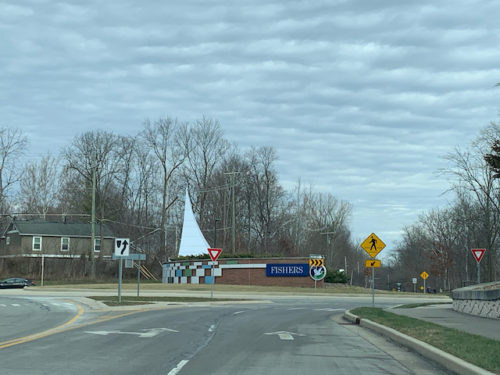
This fixture stands at the intersection of Fall Creek Road and East 96th Street, using a northward vantage point along Fall Creek Road in the above photo. 96th Street is the obvious border between the two municipalities, as well as between Hamilton and Marion counties. Several years ago, the local government decided to replace the more conventional three-way stop with a roundabout to ease traffic backups on these two equally important collector roads. The central circle remained unadorned for a few years, as this Google Street View from September 2013 indicates. But by 2016, the City of Fishers had installed the large “sail†landmark, vaguely evocative of Salvatore Calatrava, as a particularly elaborate welcome sign.
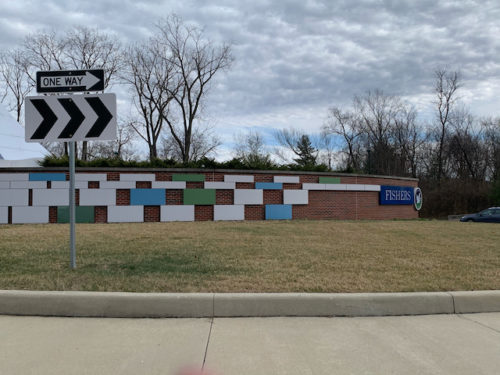
To people from elsewhere in Indiana, the sail may seem like an unusual metaphor for Fishers, a sprawling suburb that ranks today as the state’s fifth or sixth largest city, neck-and-neck with both Carmel and South Bend. But most of Fishers consists of formerly forested farmland experiencing the rapid encroachment of medium- or low-density single family detached housing developments. It’s not a place with a maritime history…except that this small portion along Fall Creek Road directly abuts Geist Reservoir, among the most affluent zip codes in all of Indiana, as well as a recreation source to the elite few who live along the waterfront or dock their boats at one of the ports.
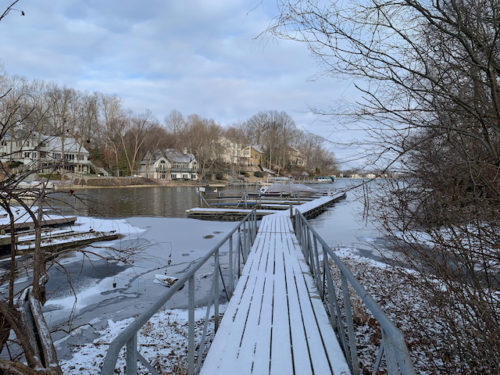

The installation at this 96th Street roundabout features a smaller seal labeled “Geist Districtâ€, indicating the entry point to portion of Fishers largely characterized by the large and wealthy housing developments that boast shoreline property along Geist Reservoir.
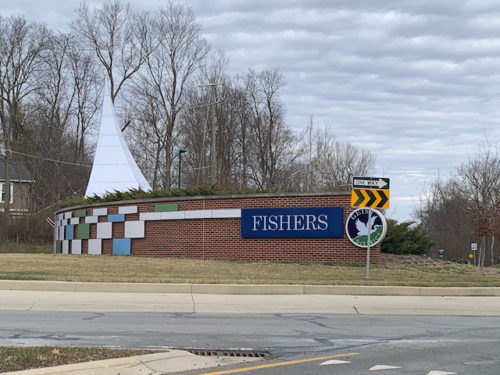
Perhaps more telling, however, is the act of circumscribing the installation using the right-of-way in the roundabout. Here’s the east side of the circle:
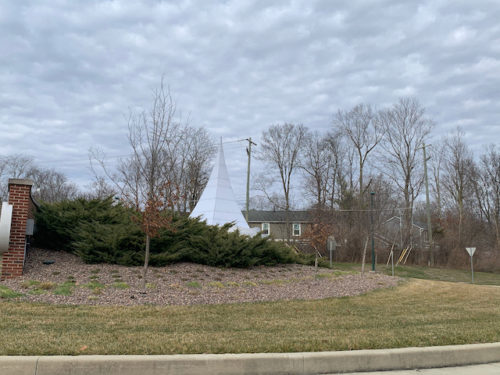
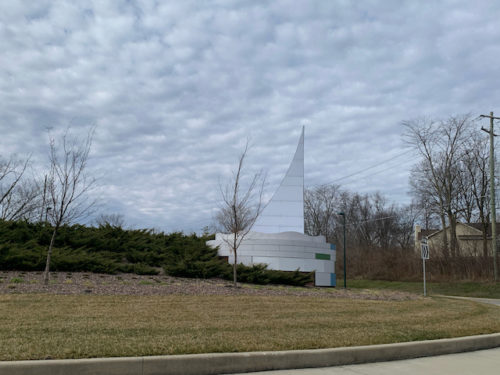
And here’s the north side, looking in a generally south-southwesterly direction, with 96th Street stretching off toward the horizon on the right side of the photo.

Needless to say, there’s not a single reference to entering Indianapolis—the core city from which Fishers largely owes its current size and prosperity—anywhere on the landmark or the entire roundabout. In fact, pivoting northward along Fall Creek Road, the camera captures another, much smaller sign announcing Fishers yet again, just off the shoulder (near the bridge portion of the sidewalk).

My suspicion is that this second sign pre-dates the sculptural installation and formerly served as the primary welcoming sign to the City of Fishers. Meanwhile, this reasonably prominent and consistently affluent entry point lacks even the most rudimentary recognition of the Indianapolis city limits for motorists traveling south along Fall Creek Road. I recall the occasional presence of such “Welcome to Indianapolis” signs during the Greg Ballard administration; though I’m sure at least a few still exist during the Joe Hogsett administration at busy entrances, I’m having a difficult time coming up with evidence of this.
Truth be told, the City of Fishers owes the City of Indianapolis nothing: if the former invested in the installation, it is only natural that it should devote the real estate toward the branding and promotion of its own incorporated municipality. Although it may seem surprising that the primary impetus for the landmark—the roundabout itself—would not involve a trans-municipal partnership (since it sits on the boundary), it is probable that the most or all of the investment in this traffic improvement came from the jurisdictions north of the line. I learned, through the discussion following an unlikely blog post in Albuquerque, that Indiana statutes dictate that the any southernmost county line road falls within the control and jurisdiction of the northern of the two counties. Therefore, 96th Street’s entire ROW is under the control of Hamilton County and/or the City of Fishers, meaning that the entire funding for this boundary roundabout came from Hamilton County (since the current municipal boundary of Fishers is proximal to, but does not explicitly encompass, the 96th/Fall Creek intersection).
In summation, Hamilton County most likely financed the roundabout, which sat fallow for a year or two, and then the City of Fishers negotiated with Hamilton County to build the installation in the middle of it, despite the fact that the closest reach of legally incorporated Fishers is approximately a quarter mile to the west (at the intersection of East 96th Street and Mollenkopf Road). Fishers then paid for that installation. And Indianapolis had absolutely nothing to do with any of it. The statutory stipulations notwithstanding, this lopsided branding reflects funding priorities in two municipalities with vastly different demographic profiles. Indianapolis, with a socioeconomically diverse population, high crime, large districts of depressed real estate, and the state’s highest concentration of tax exempt properties (due to public or nonprofit ownership), must stretch its budget across a far greater array of social services and capital improvements, leaving far less room for branding and civic art. And where it does spend it, the City is justifiably more compelled to strategize at the highest profile areas where the investment could achieve a spillover benefit or a quantifiable return—nearly always more lucrative in the 200-year-old historic center, the Mile Square or nearby.
Fishers, officially elevated from a town to a city exactly five years ago, lacks such socioeconomic diversity, being almost uniformly upper-middle or upper income.  Numerous corporate headquarters flank busy Interstate 69, endowing the municipality with greater capacity to raise its revenue through business taxation or modest taxes assessed against its generally high-value real estate. The law enforcement budget is negligible compared to Indianapolis, resulting in considerably more money devoted to alternative transportation (sidewalks, bike paths), “boutique†traffic improvements like roundabouts, and civic art, like a nautical landmark that says “Welcome to Fishers – Geist Districtâ€. This dichotomy reveals hardly a condition unique to Indy and Fishers: numerous other city/suburb pairings manifest similar disparities, often palpable from the elegant, smoothly paved roads in the fancy suburb, contrasted with pockmarked pavement in the older, poorer core city.
One compensatory feature in this case: Fishers funded the protruding “sail sculptureâ€, which, at night is bathed in a floodlight so bright that it’s almost a distracting nuisance to the neighbors. Then again, since it stands right on the municipal boundary, Geist residents in both Indianapolis and Fishers must bear the brunt of the nuisance. And thus the political tug-of-war continues.
A variation of this article originally appeared in the blog American Dirt.